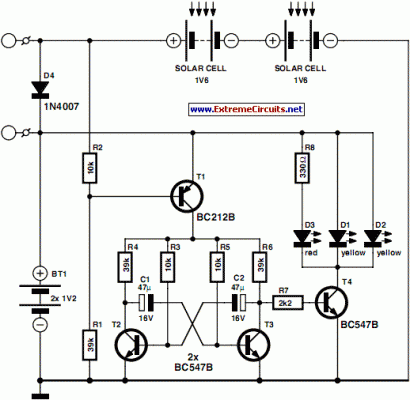- Dancing LEDs Circuit Diagram
- Dark Activated Led or Lamp Flasher
- Two Flashing LEDs Circuit Schematic
- Dicing With LED's
- Bicycle Back Safety Light Circuit Schematic
- AC 220 Volts Flashing Lamps Circuit
- Smooth Flasher Circuit Diagram
- Portable Lamp Flasher
- One Of Nine Sequencer
- Led or Lamp Flasher Circuit
- LED or Lamp Pulsar Circuit
- High-intensity LED Warning Flasher
- Flashing Eyes
- Fading Leds Circuit Diagram
- 12 Stage Neon Sequencer (NE-2 / NE-51)
High-intensity LED Warning Flasher
Circuit diagram:
Description
This circuit was designed as a warning flasher to alert road users to dangerous situations in the dark. Alternatively, it can act as a bicycle light (subject to traffic regulations and legislation). White LEDs only are recommended if the circuit is used as a bicycle front light (i.e. for road illumination) and red LEDs only when used as a tail light. During the day, the two 1.6-V solar cells charge the two AA batteries. In darkness, the solar cell voltage disappears and the batteries automatically power the circuit. The flash frequency is about one per second and the LED on-time is about 330 ms.
The duty cycle should enable the batteries to power the circuit over night. The circuit is composed of three parts. Under normal daylight conditions the batteries are charged through diode D4. In darkness, pnp transistor T1 is switched on, supplying battery current to the second part, a low-frequency oscillator comprising T2 and T3. The third part is the LED driver around T4. It conducts and switches on the LEDs D1-D2-D3 when the collector voltage of T3 swings high.
Two LEDs (D1, D2) are 20,000-30,000 mcd high-brightness yellow types and one (D3) is a normal 3-mm red LED for control purposes. Of course it is possible to increase the number of LEDs to obtain higher brightness. However you will run into limitations regarding the maximum collector current of transistor T4. For really high power applications a MOSFET transistor is suggested instead of the common or garden BC547B.
circuit from http://www.extremecircuits.net/2010/05/high-intensity-led-warning-flasher.html
